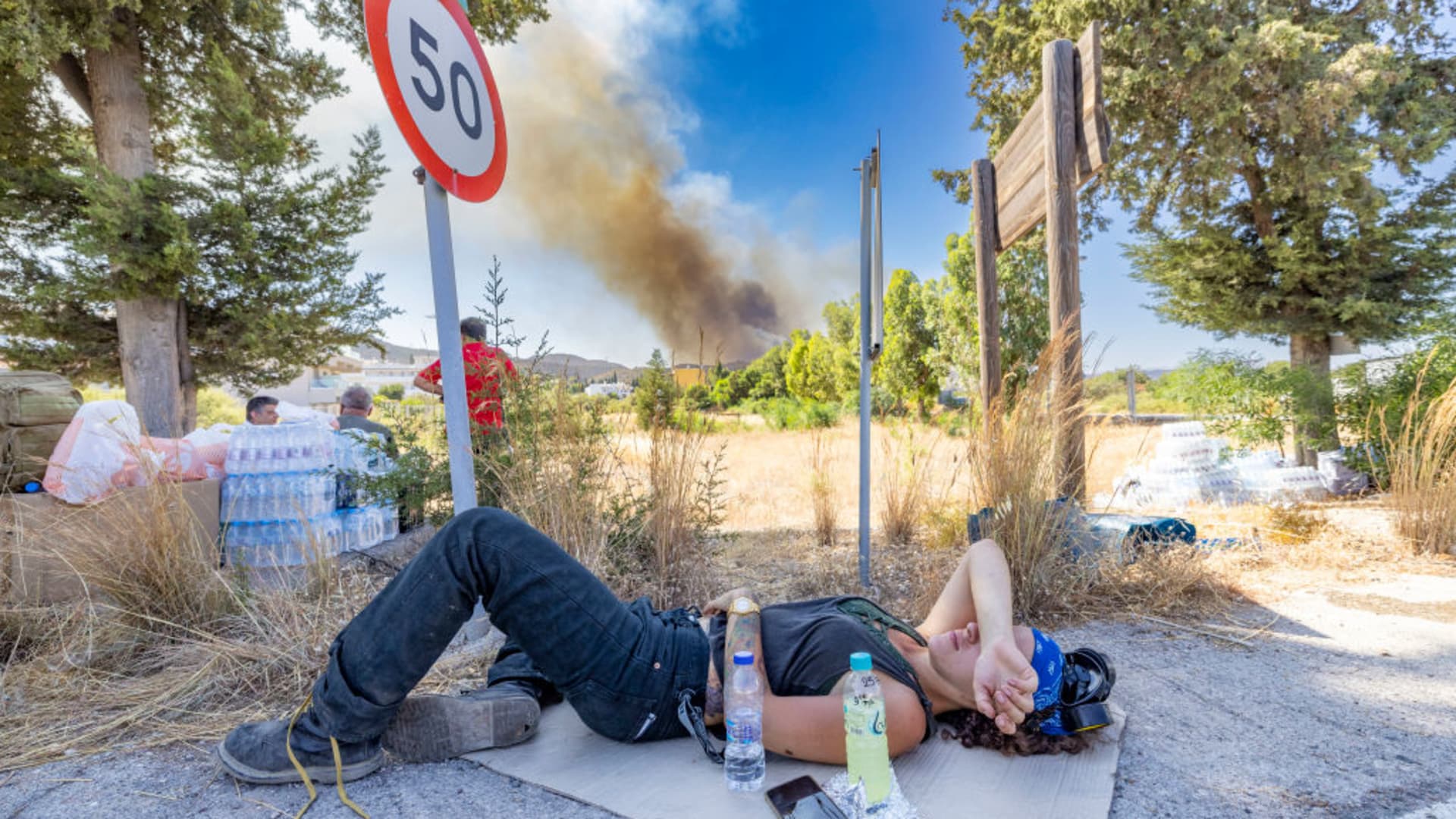July is set to be the hottest month on record
July is set to be the hottest month on record CNBC


July 2023: Hottest Month on Record

Introduction
July is set to be the hottest month on record, according to data released by Copernicus, the Earth observation component of the European Union’s space program, and supported by the World Meteorological Organization (WMO), the United Nation’s agency for weather, climate, and water.
Record-Breaking Heat
- The first three weeks of July have been the hottest three-week period on record.
- This month’s record-breaking heat surpasses July 2019, the previous hottest month.
- Climate change is primarily responsible for these extreme temperatures.
Impact of El Nino
- The El Nino weather pattern is active for the first time in seven years.
- There is a 90% chance that El Nino will continue for the second half of 2023, exacerbating weather extremes.
Global Heatwaves and Wildfires
Heatwaves have affected North America, Asia, and Europe, while wildfires are ravaging Canada and Greece.
Call to Action
The World Meteorological Organization emphasizes the urgent need to reduce greenhouse gas emissions and take climate action to mitigate the effects of climate change.
Future Projections
- The WMO estimates a 98% chance that one of the next five years will be the hottest on record.
- There is a 66% chance that, in one of the next five years, the global average temperature will temporarily exceed the goal of the 2015 Paris Climate Agreement to limit the temperature increase to 1.5° Celsius above preindustrial levels.
- However, exceeding this threshold temporarily does not necessarily mean it will remain permanently above this level.
SDGs, Targets, and Indicators
| SDGs | Targets | Indicators |
|---|---|---|
| SDG 13: Climate Action | Target 13.1: Strengthen resilience and adaptive capacity to climate-related hazards and natural disasters | Indicator not mentioned in the article |
| Target 13.2: Integrate climate change measures into national policies, strategies, and planning | Indicator not mentioned in the article | |
| Target 13.3: Improve education, awareness-raising, and human and institutional capacity on climate change mitigation, adaptation, impact reduction, and early warning | Indicator not mentioned in the article | |
| Target 13.a: Implement the commitment undertaken by developed-country parties to the United Nations Framework Convention on Climate Change to a goal of mobilizing jointly $100 billion annually by 2020 from all sources to address the needs of developing countries in the context of meaningful mitigation actions and transparency on implementation and fully operationalize the Green Climate Fund through its capitalization as soon as possible | Indicator not mentioned in the article | |
| Target 13.b: Promote mechanisms for raising capacity for effective climate change-related planning and management in least developed countries and small island developing States, including focusing on women, youth, and local and marginalized communities | Indicator not mentioned in the article | |
| SDG 15: Life on Land | Target 15.1: By 2020, ensure the conservation, restoration, and sustainable use of terrestrial and inland freshwater ecosystems and their services, in particular forests, wetlands, mountains, and drylands, in line with obligations under international agreements | Indicator not mentioned in the article |
| Target 15.2: By 2020, promote the implementation of sustainable management of all types of forests, halt deforestation, restore degraded forests, and substantially increase afforestation and reforestation globally | Indicator not mentioned in the article | |
| Target 15.5: Take urgent and significant action to reduce the degradation of natural habitats, halt the loss of biodiversity, and, by 2020, protect and prevent the extinction of threatened species | Indicator not mentioned in the article |
1. Which SDGs are addressed or connected to the issues highlighted in the article?
SDG 13: Climate Action
The article discusses record-breaking heatwaves and attributes them to climate change. This aligns with SDG 13, which focuses on taking urgent action to combat climate change and its impacts.
SDG 15: Life on Land
The article mentions wildfires that are ravaging Canada and Greece. This relates to SDG 15, which aims to protect, restore, and promote sustainable use of terrestrial ecosystems, sustainably manage forests, combat desertification, halt and reverse land degradation, and halt biodiversity loss.
2. What specific targets under those SDGs can be identified based on the article’s content?
Target 13.1: Strengthen resilience and adaptive capacity to climate-related hazards and natural disasters
The article mentions the need to address climate-related hazards and natural disasters caused by rising temperatures.
Target 13.2: Integrate climate change measures into national policies, strategies, and planning
The article highlights the importance of integrating climate change measures into national policies and strategies to address the increasing temperatures.
Target 13.3: Improve education, awareness-raising, and human and institutional capacity on climate change mitigation, adaptation, impact reduction, and early warning
The article emphasizes the need to improve education and awareness on climate change mitigation and adaptation to address the rising temperatures.
Target 15.1: By 2020, ensure the conservation, restoration, and sustainable use of terrestrial and inland freshwater ecosystems and their services
The article mentions the need to protect and conserve ecosystems affected by the wildfires.
Target 15.2: By 2020, promote the implementation of sustainable management of all types of forests, halt deforestation, restore degraded forests, and substantially increase afforestation and reforestation globally
The article highlights the wildfires that are causing forest destruction, indicating the importance of promoting sustainable forest management.
Target 15.5: Take urgent and significant action to reduce the degradation of natural habitats, halt the loss of biodiversity, and protect threatened species
The article mentions the need to take action to prevent the extinction of threatened species affected by the wildfires.
3. Are there any indicators mentioned or implied in the article that can be used to measure progress towards the identified targets?
No specific indicators are mentioned or implied in the article that can be used to measure progress towards the identified targets.
4. SDGs, Targets, and Indicators
| SDGs | Targets | Indicators |
|---|---|---|
| SDG 13: Climate Action | Target 13.1: Strengthen resilience and adaptive capacity to climate-related hazards and natural disasters | Indicator not mentioned in the article |
| Target 13.2: Integrate climate change measures into national policies, strategies, and planning | Indicator not mentioned in the article | |
| Target 13.3: Improve education, awareness-raising, and human and institutional capacity on climate change mitigation, adaptation, impact reduction, and early warning | Indicator not mentioned in the article | |
| Target 13.a: Implement the commitment undertaken by developed-country parties to the United Nations Framework Convention on Climate Change to a goal of mobilizing jointly $100 billion annually by 2020 from all sources to address the needs of developing countries in the
Behold! This splendid article springs forth from the wellspring of knowledge, shaped by a wondrous proprietary AI technology that delved into a vast ocean of data, illuminating the path towards the Sustainable Development Goals. Remember that all rights are reserved by SDG Investors LLC, empowering us to champion progress together. Source: cnbc.com
Join us, as fellow seekers of change, on a transformative journey at https://sdgtalks.ai/welcome, where you can become a member and actively contribute to shaping a brighter future.
|








